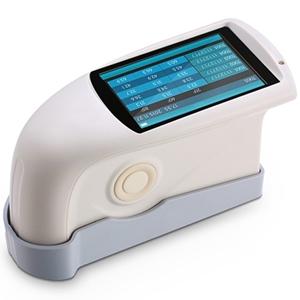How to Detect the Surface Gloss of Lime-Glaze with Gloss Meter?
Lime glaze is a commonly used glaze in the production process of traditional lime glaze ceramic. Due to the difference in raw materials and calcination process, the appearance and color of lime glaze will be different. In order to verify the surface gloss of lime glaze, a gloss meter can be used to measure.
Lime glaze gloss requirements
The lime glaze uses calcium oxide as the flux, and the glaze whose molecular number of calcium oxide should account for more than half is the lime glaze. The production of lime glaze is firstly mining limestone, calcining it into quick lime (calcium oxide), adding water naturally or artificially to digest it into mature lime, and then superimposing it with the wolf calyx grass, and using the carbon dioxide produced by the frantic burning wolf calyx grass to turn the slaked lime into carbonic acid.
The calcium oxide in the glaze has the effect of reducing the melting temperature of the glaze, the high temperature viscosity is low, it is easy to flow, the glaze layer is thin, and the glass texture is strong. Due to the high transparency, the glaze color is greatly affected by the fetal color. In addition, the firing range is narrow and the products are susceptible to smoke. The difference in the chemical composition of lime glaze and the firing process will also affect its surface color.
Color and gloss are important indicators to evaluate the appearance quality of lime glaze. In order to accurately identify the surface gloss of lime glaze, it can be measured by professional instruments.
Gloss meter detects the surface gloss of lime glaze
When testing, different gloss meters may have different requirements for use, so it should be operated according to the instructions of the gloss meter used.
 Start up normally
Start up normally
The gloss meter is a photoelectric measuring instrument, which can work normally only when it is powered on. If the battery of the instrument is low, or if the USB is not connected, it may not be able to power on properly.- Instrument calibration
When the instrument is used to measure money, it is necessary to calibrate the instrument. However, many gloss meters now support automatic calibration, which can save users time and improve measurement efficiency. - Select the measurement angle
Different measurement angles, we have detected that the gloss of the lime glaze is different, so we need to select the corresponding measurement angle. At present, there are also three-angle gloss meters on the market, which can measure the gloss at three angles at the same time, which is very convenient. - Measure and analyze
Take point measurements on the surface of the sample, calculate the average of all measured gloss values, and then evaluate the average gloss of the surface of the lime glaze sample.
Note: The surface of the lime glaze sample should be smooth without blisters and other appearance defects, and the surface of the sample should be wiped clean before measurement. And the surface of the lime glaze sample should be flat without bending. Because the commonly used gloss meter measures the surface gloss of flat objects, if it is a curved sample, the measuring aperture will not be able to closely fit the sample to be tested, and the external light will interfere with the test result.

